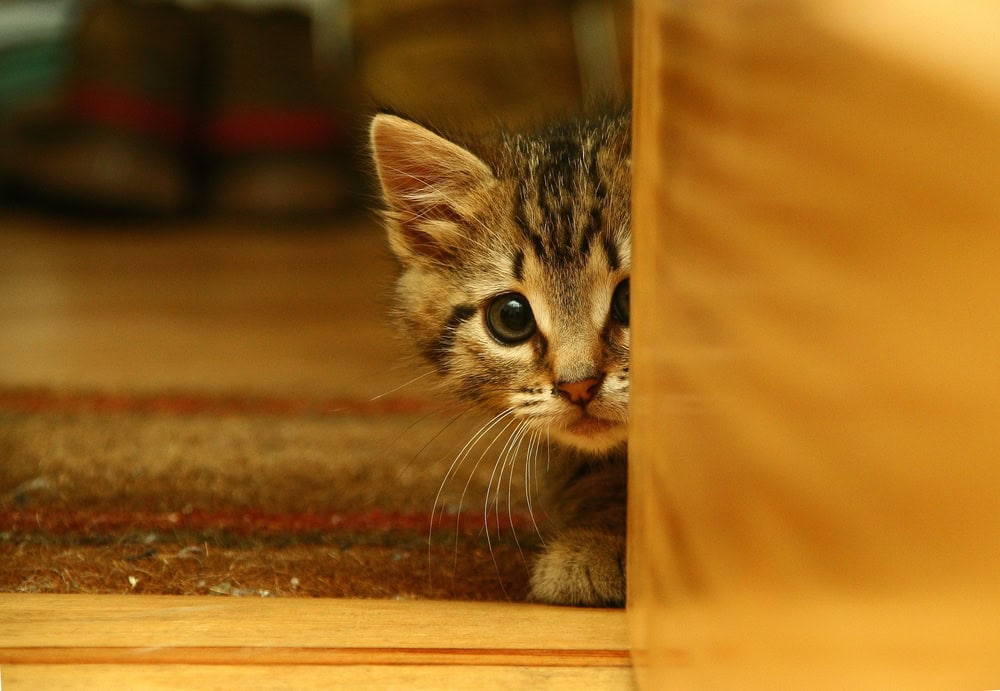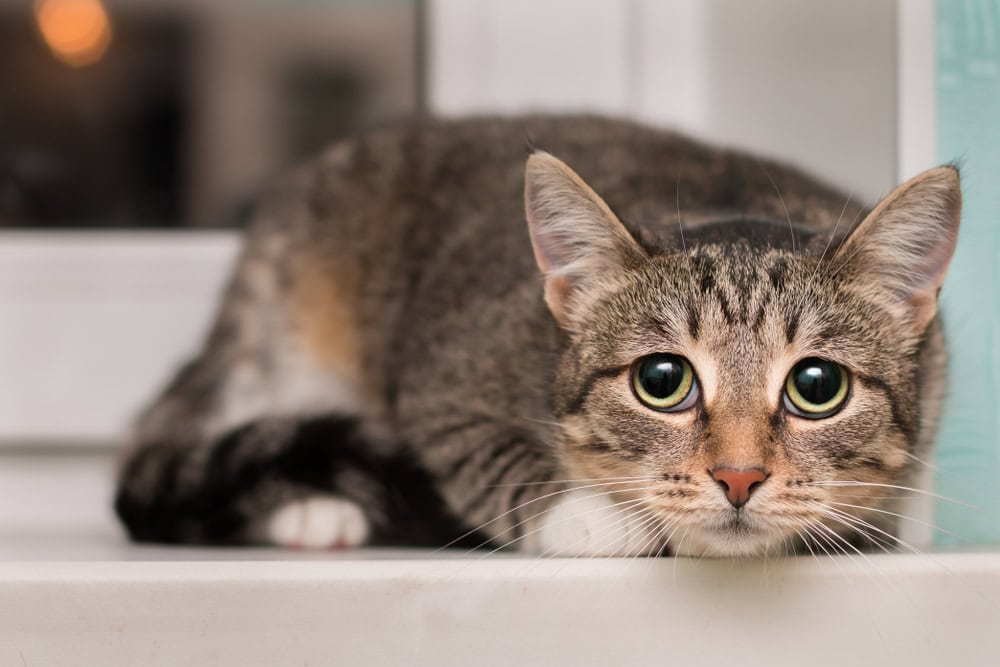How to Tell If a Cat Is Scared? Vet-Verified Signs, Triggers & Consequences
By Ashley Bates
Updated on

The term “scaredy cat” didn’t come from nowhere—and Halloween has no shortage of prickly, arched black cats on display. But scared cats don’t always have extreme reactions, and not all fear elicits the same response.
Also, being scared suddenly is pretty apparent, but you might not see other more subtle signs of longer-term stress, anxiety, and fears. So, let’s talk more in-depth about how cats express fear and how to pinpoint it when it happens.
These Things Happen When a Cat Is Scared
When a cat is suddenly scared, their body language will give certain clues about their emotional state. However, some of these clues will be more subtle than others because Physiological changes also take place.
Body Language
Here are some bodily cues that your kitty just isn’t having a good time:
- Hunching – A frightened cat might hunker down to the ground cautiously.
- Arching – A frightened cat might arch their back.
- Hair Raised – We’ve all seen the hair stand up on a cat when they’re angry or frightened!
- Fleeing and hiding- A cat might run away to hide when they spot the first sign of danger.
- Attacking – If a cat feels threatened enough, they might attack out of perceived necessity.
- Springing – A cat who is scared suddenly might pop right up in the air before bolting.
- Shaking – Like us, cats might shake or tremble out of fear.
- Acting Skittish – Cats might act erratic or neurotic when they’re scared.
- Dilated pupils- A cat that is scared or in pain can present enlarged round pupils.
- Airplane ears: Lowered and flattened or sideways ears indicate a cat is scared or angry.
- Drooling: Increased salivation can also be a sign of anxiety, stress, and fear in cats.
Physiological Changes
- Increased heart rate.
- Increased respiratory rate.
- Increased blood pressure.

Vocalizations
You might notice certain vocalizations when your cat is frightened:
- Hissing – A hiss is the classic warning we all know.
- Growling – Growling can change in pitch and mix with other vocalizations when your cat is feeling vulnerable.
- Screeching – Screeching is typically the sound cats make when danger is truly imminent or they are being attacked.
- Meowing – Nervous meowing for seemingly no cause can be a panicky sign from your cat that they feel unsafe.
Triggers Matter
What scares your cat could make a big difference in their reactions. For instance, if they feel like their lives are threatened by another animal, they might attack out of necessity.
However, if you scare them with a vacuum, they might spring up and run away. Or a thunderstorm might be going on outside, and they are ducking for cover. It just depends on what happens.
Nervousness is another story entirely. Naturally shy or nervous cats might exhibit consistent over-reactions to normal stimuli.
If your cat is scared, there’s likely an underlying reason—you just need to pinpoint the cause. It shouldn’t be difficult in most cases. But if it seems challenging, consider getting help from a professional behaviorist. They have the experience to help analyze the scenarios and recognize the potential triggers.

Anxiety in Cats
Anxiety is a disorder that humans know all too well. If you have a cat that seems always scared, it could be anxiety. Anxiety can cause overreactions in cats that might seem like too much for a particular circumstance.
- Trembling
- Erratic pacing
- Quick mood changes or altered mood
- Excessive meowing
- Losing weight
- Toileting outside of the litter box
- Hiding
- Destructive behavior
- Compulsive behaviors
- Excessive grooming
If your cat suffers from severe anxiety, it might warrant medication or other treatment. You can speak with your veterinarian or veterinary behaviorist on how to ease your cat’s mental state.
Early Interactions That Trigger Fear
Some cats will remain cautious or afraid of it their whole lives if they have bad experiences or interactions as kittens. For instance, if a toddler yanks your cat’s tail and hurts them, they might carry a lifelong fear of small children. Kittens go through a developmental phase around two to seven weeks old when they are particularly sensitive to frightening situations.
Obviously, trauma can cause some lasting effects in adult humans,—and it’s the exact same for animals. You have to remember that even though something might affect one kitten severely, another kitten in the same circumstance may go unscathed.
And how animals react can be influenced by genetics, personality, and life experience. For example, in this study, it was discovered that there is a direct link between genetics and personality traits such as feline shyness and fear-induced aggression toward humans.

When Fear Leads to Aggression
It’s one thing if your cat is defending themselves against a predator. It’s quite another if they’re attacking other pets or people in your home. If your cat is afraid of a person or other animal, they might lash out if they feel threatened—even if no real threat exists.
These fearful reactions can be linked to health issues, but we do need to be concerned for housemates and their safety. It’s important to protect other animals and humans from cats who have fear-induced aggressive reactions, but getting to the root cause is the first pathway toward recovery.

Loud Noises & The Orienting Response
If a cat hears a loud, novel, and unexpected noise, their survival instinct is triggered by what is known as the orienting response. The acoustic stimulus needs to be analyzed to check out the possibility of it being a treat to your cat. If a cat is unsure, they are likely to run and hide, but a physiological response, including increased heart rate, blood pressure, and respiratory rate might be present. A cat in this scared state might also respond with aggression.
Gradual desensitization and counter-conditioning techniques can help these cats, but the challenge is real.
Pain
Pain in cats can stem from injuries or health issues, like arthritis. If your cat is internally hurting, it could cause them to hide or avoid contact or seem fearful of those around them. They may avoid their usual activities and routines.
Normal petting or playing with a feline friend might cause them more trouble than it’s worth. If you handle your cat and notice that they have areas of discomfort, they lash out or squirm and scramble to get away, don’t hesitate to get them to your vet for evaluation.
Illness
If your cat has other illnesses, it could cause changes that trigger erratic behaviors. If you notice your cat isn’t acting like themselves, it’s essential to look for other cues that could cause the shift.
You might notice other signs like nausea, vomiting, coat changes, lethargy, or diarrhea. Pay close attention so you can note any changes to your vet.

Lack of personal space
Cats are very territorial, and if their space is continually being invaded, or even worse, they feel displaced, you can imagine how that might negatively impact a loner cat over time. Being berated can be stressful. So, if you have two cats with conflicting personalities where one is very intense and playful, and the other is quiet and solitary, it could cause some friction.
If your cat needs some alone time to recharge their batteries and rest, make sure they have a safe haven to run to when they just aren’t in the mood. You can install cat shelves and closed in baskets for your cat.
Likewise, it is important for each cat to have their own litterbox; in fact, the rule is one litter box per cat plus an extra one to avoid stress, conflict, displacement, and the resulting mess or health problems.

Novel Fear Reactions vs Fear Related to Experience
Many cats are fearful simply due to lack of experience. If they are around something unfamiliar, it’s likely to cause insecurity and questionable reactions. For instance, if your cat has never seen a dog before, they might react poorly the first time they meet one.
After a while of exposure, fears usually dissipate once they see that no threat exists. However, the worst-case scenario is that something happened during the initial stages of uncertainty, which adds to the fear of what is going on.
For instance, if your cat escapes your home and has never seen anyone on the outside, having a bad run-in with your neighbor chasing them off their porch with a broom might cause lifelong panic over broom-related scenarios, strangers, or from crossing the door. Of course, you might not have to worry about your cat trying to escape your home anymore, but you do have to worry about the fear of newcomers—or brooms, for that matter.
A cat who has had any type of abusive reaction from a human might develop a fear of strangers, causing them to hide or act aloof if company comes over. But that same defense might not be present among the family.
Some Considerations When Bringing a New Cat Home
Fear is an inevitable part of rehoming when you get a new cat. When they are placed in their forever homes, it will cause a total readjustment period. Reactions are nearly guaranteed in adults and still quite common among young kittens, though maybe not as prominently.
Many like to tout that you can’t tell a cat’s personality while they’re young. However, if you are looking for a highly social cat that can be a part of your everyday life, it’s best to get a social kitten as opposed to one that is hiding in the corner.
We aren’t recommending that you write off a skittish kitten from your mind entirely. You must be more patient and cautious with them, but they may still be more likely to develop fearful or antisocial behaviors as adults.

Kittens
If you get a new kitten, remember that they are away from their mother and siblings for the first time. They no longer have their buddies to romp with, mother to cuddle, or familiar surroundings. As you can probably imagine, this isn’t reassuring to a kitten.
Luckily, kittens are resilient little creatures and adapt to a new environment in just a few short days. Some might take longer than others. If you have a more fearful baby, you might try extra steps to eliminate initial noise and introduce them to household members slowly.
They might grow out of some fearfulness with their housemates but may still be wary of strangers—animal and human alike.
Adults
If you adopted, found a stray, or otherwise took on the responsibility of an adult cat, they are much more set in their ways. Because of that, it can be quite challenging for them to adapt. This is especially true if their new home has unfamiliar stimuli that trigger their fight-or-flight response.
For instance, if your cat has never seen a dog and you have three—you can imagine how terrifying that probably is.
When you are picking out your cat, you may or may not notice certain mannerisms or behaviors that indicate anxious, fearful, or stress-related states. They need time to learn and trust.
Allow the newcomer some time to adapt, trying to acclimate them slowly. They might have a lower tolerance to novel stimuli than kittens, especially if they have negative past experiences and associations. Remember to be patient and understanding as they undergo this transition.

Final Thoughts
If you’re dealing with a particularly scared, reserved, or uncertain kitty, you should take measures to ensure they feel safe and sound. Survival instincts, past experiences, physical health, and their perception of the different stimuli in the environment all play a role. Understanding the signs and the root cause are the first steps towards helping your scared cat feel better and more secure. After all, we all deserve to feel safe, loved and protected.
We hope this article helped you understand the possible causes behind your fearful feline and taught you more about their unspoken language.
See Also:
Featured Image Credit: Rawpixel.com, Shutterstock













